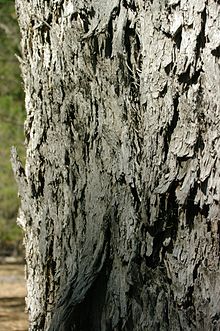Eucalyptus gomphocephala
| Eucalyptus gomphocephala | ||||||||||||
|---|---|---|---|---|---|---|---|---|---|---|---|---|

Eucalyptus gomphocephala |
||||||||||||
| Systematics | ||||||||||||
|
||||||||||||
| Scientific name | ||||||||||||
| Eucalyptus gomphocephala | ||||||||||||
| DC. |
Eucalyptus gomphocephala is a species ofthe myrtle family (Myrtaceae). It occurs in the southern part of the west coast of Western Australia and on the south coast of South Australia and is called "Tuart" or "Tuart Gum" there.
description
Appearance and leaf
Eucalyptus gomphocephala grows as a tree that reaches heights of up to 10 to 40 meters. The bark remains on the entire tree, is gray and has short fibers. There are oil glands in the marrow of the young branches, but not in the bark.
In Eucalyptus gomphocephala , heterophyllia is present. The leaves are always divided into a petiole and a leaf blade. The leaf stalks are narrowly flattened or channel-shaped. In seedlings , the leaf blade, which is green on the top and bottom, is 6 to 9 cm long and 4 to 7 cm wide and is egg-shaped, often heart-shaped. On young specimens, the leaf blade, which is differently colored on the upper and lower side, is 9 to 15 cm long and 5.5 to 10 cm wide and is egg-shaped to heart-shaped. The leaf blade of the same color on the upper and lower side on medium-old specimens is 12 to 20 cm long and 3 to 5 cm wide and lanceolate or elliptical to ovate, straight and with entire margins. The dull green or gray-green leaf blades of the same color on the upper and lower side on adult specimens are lanceolate, sickle-shaped, with a length of 9 to 16 cm and a width of 1.6 to 2.5 cm, tapering towards the base of the blade be relatively thin or relatively thick and have a blunt top. The side nerves, which are barely recognizable, extend from the median nerve at an acute angle. The cotyledons ( cotyledons ) are in two parts.
Inflorescence and flower
On the side of a 13 to 27 mm long inflorescence stem with a wide flattened cross section, there are about seven flowers together in a single inflorescence . If available, the flower stalks are up to 4 mm long. The not blue-green floured or frosted flower buds are club-shaped with a length of 14 to 20 mm and a diameter of 8 to 15 mm. The sepals form a calyptra that falls off early. The smooth calyptra is hemispherical or conical, once or twice as long as the smooth flower cup (hypanthium) and wider than this. The flowers are white or creamy white. The flowering period in Western Australia extends from January to April.
Fruit and seeds
The seated or short-stalked fruit is 13 to 22 mm long and 13 to 17 mm in diameter, bell-shaped, rarely also cylindrical and often finely ribbed. The disc is flat or raised, the fruit compartments are level with the rim or protrude.
The seeds are kneecap-shaped, often with a base, and gray-black. The hilum sits in the middle.
Occurrence
The natural range of Eucalyptus gomphocephala is the southern section of the west coast of Western Australia , around Perth , and the south coast of South Australia , south and west of Adelaide . Eucalyptus gomphocephala occurs in Western Australia in the independent administrative districts of Bunbury , Busselton , Cottesloe , Dandaragan , Dardanup , Fremantle , Gingin , Harvey , Joondalup , Kwinana , Mandurah , Murray , Rockingham , Serpentine-Jarrahdale , South Perth , Swan , Wanneroo and Waroona in denoo regions Peel , Perth, South West and Wheatbelt before.
Eucalyptus gomphocephala grows on sandy soils over limestone . Eucalyptus gomphocephala is mainly found in coastal plains.
Taxonomy
The first description of eucalyptus gomphocephala was made in 1828 by Augustin Pyramus de Candolle in Prodromus Systematis Naturalis Vegetabilis , Volume 3, page 220. The type material has the inscription " In Nova Hollandia " link. Synonyms for Eucalyptus gomphocephala DC. are Eucalyptus gomphocephala DC. var. gomphocephala and Eucalyptus gomphocephala var. rhodoxylon Blakely & H.Steedman.
use
The heartwood of Eucalyptus gomphocephala is pale yellowish, finely structured, very hard and very persistent. Its specific weight is 890 to 1160 kg / m³.
In the past, wood was used wherever special strength was required, for example in shipbuilding for keels and stern frames , as well as bridge piers and in railway wagon construction.
Individual evidence
- ↑ a b Specimen search results: Eucalyptus gomphocephala at Australia's Virtual Herbarium. Council of Heads of Australasian Herbaria . Retrieved March 19, 2013
- ↑ a b c APNI = Australian Plant Name Index . Center for Plant Biodiversity Research. Australian Government. Retrieved March 19, 2013
- ↑ a b c d e f g h i Eucalyptus gomphocephala at EucaLink - A Web Guide to the Eucalypts . Retrieved March 19, 2013.
- ↑ a b c d e Eucalyptus gomphocephala in the Western Australian Flora . Retrieved March 19, 2013.
- ↑ a b c d e f g h Tuart - Eucalyptus gomphocephala in: DJ Boland, MIH Brooker, GM Chippendale, N. Hall, BPM Highland, RD Johnston, DA Kleinig, MW McDonald & JD Turner (editors): Forest Trees of Australia . CSIRO Publishing. 5th Edition 2006. pp. 284-285 on Google Books . Retrieved March 19, 2013
- ↑ Eucalyptus gomphocephala at Tropicos.org. Missouri Botanical Garden, St. Louis, accessed March 19, 2013.
- ↑ Rafaël Govaerts (ed.): Eucalyptus gomphocephala. In: World Checklist of Selected Plant Families (WCSP) - The Board of Trustees of the Royal Botanic Gardens, Kew . Retrieved March 19, 2013.



